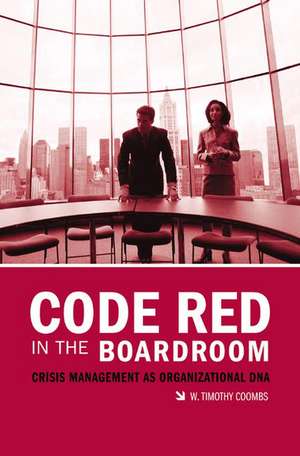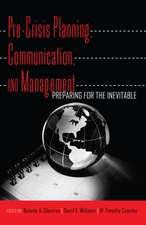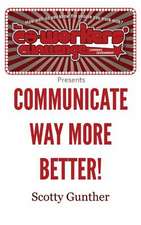Code Red in the Boardroom: Crisis Management as Organizational DNA
Autor W. Timothy Coombsen Limba Engleză Hardback – 29 mar 2006 – vârsta până la 17 ani
Preț: 362.79 lei
Preț vechi: 447.05 lei
-19% Nou
Puncte Express: 544
Preț estimativ în valută:
69.42€ • 72.67$ • 57.44£
69.42€ • 72.67$ • 57.44£
Carte tipărită la comandă
Livrare economică 05-19 aprilie
Preluare comenzi: 021 569.72.76
Specificații
ISBN-13: 9780275989125
ISBN-10: 0275989127
Pagini: 152
Ilustrații: 8 illustrations
Dimensiuni: 156 x 235 x 18 mm
Greutate: 0.39 kg
Ediția:annotated ed.
Editura: Bloomsbury Publishing
Colecția Praeger
Locul publicării:New York, United States
ISBN-10: 0275989127
Pagini: 152
Ilustrații: 8 illustrations
Dimensiuni: 156 x 235 x 18 mm
Greutate: 0.39 kg
Ediția:annotated ed.
Editura: Bloomsbury Publishing
Colecția Praeger
Locul publicării:New York, United States
Notă biografică
W. TIMOTHY COOMBS is Associate Professor in the Communication Studies Department, Eastern Illinois University, where he teaches courses in crisis management, corporate communications, and public relations. Previously on the faculty of Wayne State University, Clemson University, and Illinois State University, he is the author or coauthor of two textbooks, Ongoing Crisis Communication and Today's Public Relations, and dozens of articles in such publications as Public Relations Review, Management Communication Quarterly, and the Journal of Public Affairs. He also consults on issues of crisis management, communication, and public relations for clients in the petrochemical, construction/engineering, and healthcare industries.
Cuprins
PrefaceIntroduction: Crises Happen, So be PreparedTypes of CrisesAttacks on OrganizationsWhen things go BadWhen the Organization MisbehavesManaging CrisesCrisis Sensing NetworkCrisis Management Plan as Living DocumentCrisis Management as DNA: Overcoming Resistance to the Crisis Management ProcessAppendix A: Sample Crisis Management Plans ElementsAppendix B: Department of Homeland Security Fact Sheet for NIMSIndex
Recenzii
This compact, clearly written, and well-documented primer is especially useful for those undertaking crisis planning for the first time, particularly small organizations, including nonprofits that do not maintain in-house legal and public relations experts. While large, experienced organizations can certainly benefit from the author's emphasis on integrating crisis management into the organizational DNA, the expository style and the case studies make it particularly helpful for novice crisis planners. In part 1 Coombs examines major crisis types: attacks on organizations, such as computer hacking or product tampering; product defects or other organizational failures, such as industrial accidents; and organizational wrongdoing in the form of financial fraud (e.g., Tyco, Enron) or failure to obey or enforce government regulations. Part 2 focuses on crisis management tools: maintaining a crisis-sensing network and a living crisis management plan; overcoming resistance to change; and integrating crisis management into the organization's culture--or organizational DNA, as Coombs calls it. This part includes practical guidelines, based on organizational change literature and sound communication practices. The book ends with two appendixes: the elements of a sample crisis management plan and a US Department of Homeland Security fact sheet for crisis planning. Recommended. Upper-division undergraduate through professional collections.
Many corporations operate under the rather nave assumption that until something terrible happens, and someone in charge declares it to be a crisis, no one needs to use the word, much less think about it. Coombs advocates building crisis management into the daily life of an organization with the goal of preventing as many crises as possible and lessening the impact of those that cannot be foreseen. He describes the types of crises organizations are most likely to encounter, including attacks from without and misbehavior from within, the features of a crisis-sensing network, the benefits of a crisis management plan that serves as a living document, and methods to ensure crisis management is part of the daily corporate culture. Coombs is unflinching in his case studies, describing such crises as product liability, misconduct and boycott, and provides helpful recording instruments and strategy checklists.
Many corporations operate under the rather nave assumption that until something terrible happens, and someone in charge declares it to be a crisis, no one needs to use the word, much less think about it. Coombs advocates building crisis management into the daily life of an organization with the goal of preventing as many crises as possible and lessening the impact of those that cannot be foreseen. He describes the types of crises organizations are most likely to encounter, including attacks from without and misbehavior from within, the features of a crisis-sensing network, the benefits of a crisis management plan that serves as a living document, and methods to ensure crisis management is part of the daily corporate culture. Coombs is unflinching in his case studies, describing such crises as product liability, misconduct and boycott, and provides helpful recording instruments and strategy checklists.























